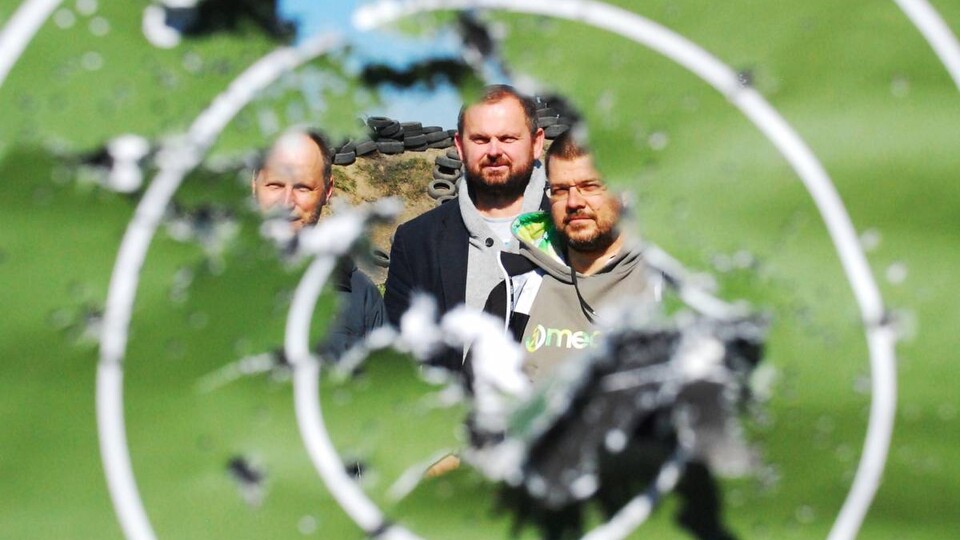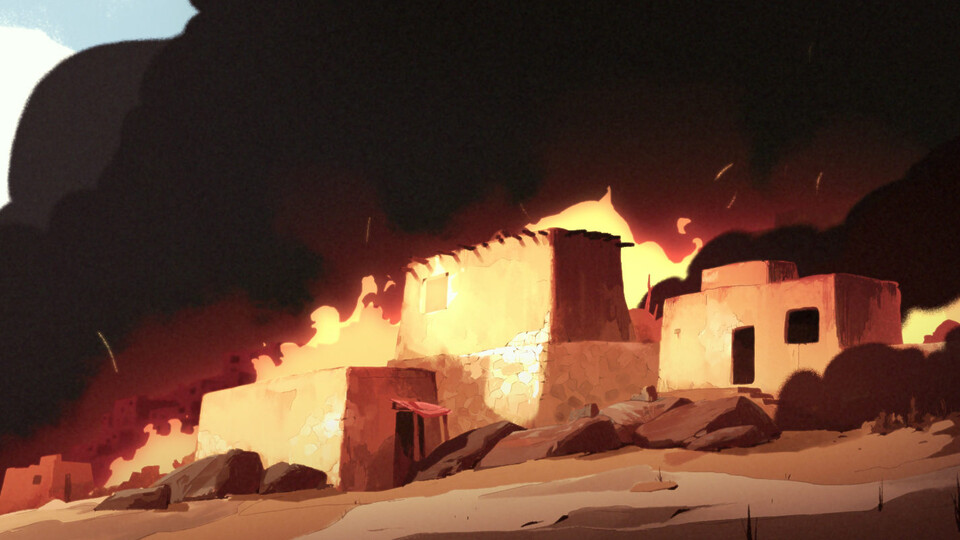The Night in Us
The night sets in. We can see a woman reaching up for a bottle of whiskey on the top shelf to drink it in the solitude of her kitchen. A lighter flashes followed by the red eye of a cigarette, a headlight of a car passing by shortly lits up the face of a prostitute standing by the road. In a tacky corner of a gambling bar, a lonesome woman is pressing buttons of the fruit machines. Lamp lights and neon and traffic lights bleed into one colourful blotch.
The Great Night, voted the best Czech documentary film of last year by the jury of the Jihlava International Documentary Film Festival is composed of similar scenes from the depth of Prague nightlife. Although at first sight, there is no clear scheme or meaning, the structure of the film is not only arbitrary or purely intuitive. On the contrary, this sophisticated work gradually opens up on several levels. What we notice first are the roughly sketched potrayals of the characters. They are people living on the outskirts of society, unseen and ignored. Their stories are therefore recounted in a voice sounding with a slight social criticism.. And yet, the esthetic and emotional aspect of the work, permeating through the whole film and creating a universal metaphor of the society, is even more pronounced than its social commentary.
The individual scenes and images presented in The Great Night are impressive on their own. This can be illustrated by the freezing night scene when the prostitutes recall the memories from their childhood: “Mum showed me how to do it. Got the first hit of herion when I was thirteen. With crystal meth. And when she found out that I am in withdrawal, she told me to make the money myself.” Other prostitutes in the film suffer a similar fate. This theme is further developed and transformed suggesting a cycle of thwarted lives – one of the women becomes pregnant during the film, but keeps on selling her body and shooting crystal meth in the park.
This and other protagonists’ stories are not completely unrelated. The opening scene shows a manufacturing line on which common people assemble slot machines. These are covered by plastic, and watched in the darkness of the warehouse by a normal security guard, waiting indifferently for misguided players. The film indicates that everyday hard work only contributes to the cycle of illusions and subsequent sobering. The margins of society cannot exist without a centre. These two are mutually interdependent – prostitutes would not walk the pavements without their clients, as pointed out in the film, albeit only momentarily in the dialogues of women on the street.
 |
 |
The Great Night
The captured social exclusion of the outcasts is only one of the aspects, and definitely not the main one. In fact, this topic gets lost in the loose structure of the film and the disparate variety of its protagonists. The Great Night does not only show the negative aspects of night life or the society, but also their attractive aspects. An athletic aging boxer Zdeněk confidently moves through the landscape of gambling bars and heroin sold at public toilets. After a month in a coma, his fragile relationship with one of the protagonists breaks up, however, this Don Quijote of the night does not seem to have any problem finding a new one. Despite his condition, he radiates enthusiams and invincibly embarks on a new adventure. A young girl called Ornella is the most notable of all of the characters. She is apparently not an addict, except for her passion for dancing at night clubs. But obviously, Ornella does not derive satisfaction from her self-intoxicating dance or high turnover of partners. Escape to nightlife and living in the moment is what she shares with other characters. This life approach is also accentuated by Zdeněk’s nihilist confession: “We people are things. For instance, when you see a bench or a piece of junk metal, we are basically the same. We will just come up in steam, and nothing will be left. Seriously. It’s just a matter of how long the sun will shine and how long the earth will be able to take it.”
Ornella’s mother Helena, another of the film’s protagonists, who, being an alcoholic, fits with the others, is also smitten with existential anxiety. Helena’s home is crammed with junk and so is her life. However, without any explanation, her character changes, the mess disappears, Helena carefully wipes the dust off the shelves and joins her daughter on a trip to Paris - her dream that has come true. The question is, to what extent has this turning point, indicating a potential positive development and hope, been envisaged in the film’s script. The story of Helena and Ornella infuses the film with ambiguity and it may also seem that the author was not sure what he wanted to say. All the more so that it is left unfinished – we know almost nothing about the past of the characters or what is the exact nature of the relationship between the mother and the daughter. We are left with a feeling of despair, when one of the closing scenes shows Helena sitting at home and drinking again, with no further explanation. The film features more elements that could develop into stories, but they do not.
The film’s ambiguity is further supported by the film’s language. In many of the scenes, The Great Night transfers its message without words. Lonely characters staring at us in long shots. The camera often follows them from behind, as if stumbling through the city on a pilgrimage, to which, thanks to the skillful editing, there seems to be no beginning and no end. And when the characters do speak, their utterances are intentionally pruned so that we can only hear snatches of monologues or trivial dialogues. Emotions hidden behind words prevail. From vulgarity to tenderness, from self-absorption to self-pity. In one of the scenes, the camera is moving away from Helena having a sentimental monologue, drunk, passing stacks of boxes and other mess filling her flat and her words are swallowed by the darkness of the staircase in the corridor. As if even the language itself and its “daily” function was deformed deep inside the night or at the bottom of the existential abyss.
 |
 |
The Great Night
The official synopsis presents The Great Night as a “documentary exploration of the modern phenomenon of night life and insomnia”. However, this introduction may obscure the important aspects of the film. The documentary takes place exclusively at night, not only due to the fact that its actors live mostly at night, but rather because the night setting accentuates the hopelessness of the lives of its protagonists. In terms of physics, night is an absence of sunlight. But because human perception relies mainly on vision, night is seen as more complex and attributed negative connotations. And this is the reason for the consistent use of night shots in The Great Night. The film does not shed any light on the people on the margins of the society, it relates us to them through the darkness of our unconsciousness, evoking the archetypal perception of night, which is intrinsic to us. There is no rational description which could capture boisterous night life, alcohol, drugs or human sexuality; they are both deterring and fascinating, belonging more to the night than to the bottom. Rather than a portrayal of insomnia, this film is a multilayered exploration of the night inside the human soul. And this represents a parallel to the dark side of civilization. And as the film shows, the one cannot exist without the other. As there is no day without night, people on the periphery cannot live witout society that produces them and, in a way, sponges on them.
The director Petr Hátle avoids standard documentary techniques. He does not show interaction of the author and the actors, does not employ a spoken commentary or opinions of experts. The characters are left to themselves and their environment, thus enhancing the cinematographic effect. All the more that the film shows snippets of stories, traces of narratives that are so fragmentary that they do not form any compact shape. The result is an abstraction of the life of people on the margins of society and their escape from their own lives, effective and multilayered digest with gaps to be filled by the viewers themselves. Or they may be overwhelmed by the pointlessness and interchangeability of the characters’ thwarted lives. Petr Hátle has thus invented a new way of speaking about topics that seemed to have been covered by socially critical documentary films.
Translated into English by Bára Rozkošná.



